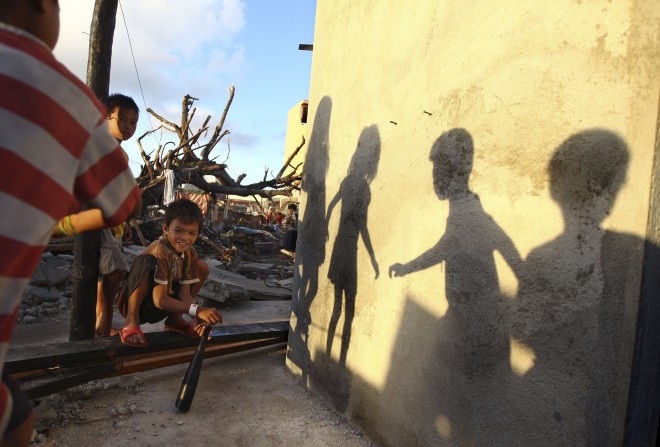Child labor up in ‘Yolanda’-hit areas – ILO

In this Nov. 15, 2013 file photo, Filipino children play in a neighborhood badly affected by Typhoon Haiyan in Guiuan, Philippines. The United Nation’s labor agency says a study has found more children toiling in harsh and dangerous work in Philippine villages hit by Typhoon Haiyan last November. The International Labor Organization said Wednesday, June 11, 2014 that a joint assessment made in March and April by the U.N. and other humanitarian organizations and Philippine authorities showed 54 percent of 112 surveyed villages reported that children there were involved in harsh and dangerous labor, with 39 percent of them saying the number of such children increased after the typhoon struck. AP
MANILA, Philippines — A study has found more children toiling in harsh and dangerous work in Philippine villages hit by Super Typhoon “Yolanda” last November, the United Nation’s labor agency said Wednesday.
The International Labor Organization said a joint assessment made in March and April by the UN and other humanitarian organizations and Philippine authorities showed 54 percent of 112 surveyed villages reported that children there were involved in harsh and dangerous labor, with 39 percent of them saying the number of such children increased after the typhoon struck.
The typhoon killed more than 6,300 people and displaced 4 million others, worsening poverty in the central Philippines.
The villages and 125 schools surveyed were randomly selected from two central regions most affected by Haiyan, with individuals interviewed from each village or school.
Giovanni Soledad of the ILO’s child labor program said it was not clear how many more children started working in dangerous conditions after the earthquake. He said further assessments will be done to find out where the children are so services can reach them.
Article continues after this advertisementBut government data prior to the typhoon showed as of 2011 that there were 1.6 million child workers aged 5 to 17 in the two regions covered by the assessment. Of that number, more than 450,000 were engaged in hazardous work.
Article continues after this advertisementThe joint assessment said 82 percent of villages reported that the children had volunteered to do harsh work to support themselves or their families. Many work in farms and as household workers. Others are vendors, construction workers, fishermen, scrap collectors or pedicab drivers.
The 2011 data showed that 5.4 million out of 29 million Filipino children aged 5 to 17 were working. About 3 million of them were counted as child laborers — defined as too young to work or in jobs too harmful for their wellbeing — while the rest were doing permissible work. Ninety-nine percent of those classified as child laborers were engaged in hazardous jobs.
RELATED STORIES